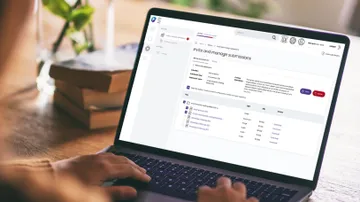Enhancing Your Digital Asset Management System
Your Digital Asset Management (DAM) system isn’t enough for Digital Preservation - read more below to understand the key benefits of combining your DAM with the power of Digital Preservation.


Digital Asset Management (DAM) × Digital Preservation
Digital Asset Management systems (DAMs) are an integral part of the information lifecycle. But DAMs are concentrated on short-term asset use — often by marketing teams that need ways to efficiently manage and distribute campaign asset and creative marketing materials like images, video, word documents, PDFs, graphics, design files and more.
These digital assets are costly to produce, but are also susceptible to loss, corruption and format obsolescence over the long-term.
Digital assets that need long-term preservation
There are many reasons why an organization would use Digital Preservation—from extending the life of their digital assets, to being able to prove authenticity, ensuring access and more. But generally, digitized and born-digital assets that require long-term preservation fit into four categories:
Governance
Heritage
Brand assets
Innovation
Shift to Digital-First. Tackle Digital Fragility.
Organizations are increasingly aware that their digital assets are fragile. Risks of long-term format obsolescence in content management requires a formal digital preservation strategy that can enhance their existing Digital Asset Management (DAM) systems.
Digital Asset Management (DAM)
- Not designed to preserve the accessibility and authenticity of brand heritage and organizational history over decades.

Shift to Digital-First. Tackle Digital Fragility.
- Consists of policies, activities, technology and strategies to make sure born-digital and digitized assets can be read by future applications and used for generations
Our future workforce shouldn’t have to worry about digital fragility.
Enterprises today are still scrambling to efficiently recreate digital assets due to issues like link rot, obsolete file formats and storage, vendor abandonment, discontinued cloud services, and storage degradation.
To preserve corporate memory, protect long-term digital information, and ensure they can be used and repurposed for decades to come, firms need a digital preservation strategy to prevent information loss due to:
- Software and other technologies becoming obsolete
- Storage formats that won’t be readable in 10 years
- Accidental damage to storage hardware
- Fast-changing technologies bring new challenges for the future
- Continuous file migration leading to loss
THE PROBLEM
Relying solely on a DAM system is not efficient to preserve the valuable digital content stored within the system. Whether you have particular file formats from earlier digital eras, or are about to embark on a project to digitize tangible assets, it’s time to think about a sustainable plan for digital preservation.
THE SOLUTION
A Future-Proof Strategy: DAM and Active Digital Preservation
Incorporating Active Digital Preservation into your Digital Asset Management (DAM) program has countless long-term benefits for every type of organization.
Empower CMOs & marketing teams
- Maximize asset ROI
- Drive brand & product innovation
- Maintain brand continuity
- Protect Intellectual Property Rights (IPR)
Ensure long-term access to information
- Securely stored & digitally preserved
- Immediately accessible
- Trustworthy source history
- Automatic conversion to future-proof formats
Create lasting corporate value for your organization
Enable better, authentic brand storytelling
Approved heritage assets for anniversary storytelling and engaging social media.
Product innovation & heritage
Inspire and document new products, innovations, retro products and heritage brands.
Employee belonging & engagement
Engage employees in the authentic history and culture of the organization.
Engage employees in the authentic history and culture of the organization.
Rapid access to proof of use assets for multiple brands, territories and jurisdictions.
Corporate governance
Protect strategic decision-making, board reports, shareholdings and M&A records.
Compliance and regulation
Rapidly meet burden-of-proof challenges for compliance and regulatory audits.
Build your most powerful DAM program
Incorporating a dedicated digital preservation system into your DAM program can go a long way for your organization.
- Authenticity Assurance. A full audit trail of the object from start to finish, able to be exported and shared with ease.
- Bit-level preservation & storage management. Plus, reporting that ensures future readability.
- Automatic file format identification, characterization and analysis.
- Preservation planning & obsolescence monitoring as new formats become obsolete or on the path to obsolescence.
- A content agnostic system, meaning all types of digital content can be ingested and preserved, including the resurrection of obsolete files.
- Scalable preservation actions driven by automation to help you keep pace with today’s information environments.
- Configurable and customizable ingest workflows to capture preservation where your information lives and control applied preservation actions.
- Multiple access/discovery options and APIs to extend and integrate preservation into your content ecosystem.
- Ensure security and compliance with comprehensive data tracking and auditing.
- Flexible storage means content can be tagged at any level for storage on a specific set of infrastructure (low value vs high value content)
Preserving long-term digital assets
The Importance of Metadata: Short-Term Vs. Long-Term Strategies
The Association for Intelligent Information Management (AIIM) defines metadata as, “Data describing stored data: that is, data describing the structure, data elements, interrelationships, and other characteristics of electronic records.“
Metadata is extremely useful for many aspects of information management, including enabling search to find and retrieve data, providing users with supporting information and a key ingredient in an Active Digital Preservation strategy.
Many Digital Asset Management (DAM) systems offer metadata options — which is a great start. However, these basic metadata elements often fall short for long-term preservation of your vital brand.
In today’s world of fake news, sales and engagement can plummet if there’s any doubt surrounding a brand. But, technology and best practices can foster the traceability of assets – who created them, what they mean, what they’re intended for – and ensure they’re not misused downstream. All powered through metadata and Active Digital Preservation.
Metadata can also be used to ensure the long-term integrity and authenticity of assets (and the metadata itself) using checksums, audits trails, and controlled access.
This underpins authenticity by preserving original meaning and context using robust archival metadata and technology to demonstrate provenance.
In summary, basic DAM metadata is valuable in helping with short-term tasks like categorization, organizing, and search. However, you can enable even more opportunities in the long-term by using a more comprehensive metadata schema such as MODs or Dublin Core—both available in Starter — Active Digital Preservation.
Your digital information safety checklist

Is the storage method safe and durable?
Storage for growing amounts of long term information needs to be durable and cost effective - this can be on-premise, in the cloud or a mix of both. Multiple copies stored across multiple locations mitigate the risk of outright loss. Active integrity checking and self-healing safeguards against any one copy becoming corrupted.

Is information organized in a way that can be trusted?
A searchable system that allows for rich metadata will make sure your information is findable and identifiable in the future. Check-sums and audit trails can prove the authenticity and trustworthiness of your most critical content - vital for legal disputes and demonstrating compliance.

Will the records stay readable and easily usable?
This is at the core of what digital preservation is for - keeping content readable and usable regardless of the application it was created in. You need an automated system for migrating obsolete file formats to newer ones over time - at scale. Files might be migrated multiple times as technology turns over and older applications become obsolete or are decommissioned.

Can you securely and quickly access any information?
Information sitting in a dark archive or backup system is value waiting to be unlocked, because it's hard to access. Make content accessible in a secure and controlled way, and you can react quickly to compliance or legal challenges. With the right system, you can open your content up to internal departments, or even make it available to the general public.

Is it easy to upload and preserve new files?
Any system designed to protect and preserve digital information for the long term needs to be a seamless part of the overall information lifecycle. You need a solution that can automatically acquire, unpack and ingest new digital content at scale, from a variety of content management and line-of-business systems.



When used in combination, DAM and Digital Preservation create a virtuous cycle that enables assets to be reused and repurposed over the long-term to grow brand value, protect corporate memory and meet compliance or litigation needs.
When valuable digital content is created in other applications, Active Digital Preservation uses seamless APIs to pull information from content locations into a preservation platform as a single source of historical knowledge.
What can you do with DAM content at the end of a contract agreement? When decommissioning applications, your valuable digital content can be migrated using Active Digital Preservation to keep this information alive in your ecosystem, even if the application itself has become obsolete.
Getting stakeholder buy-in
Conveying the value of a standards-based preservation solution to stakeholders is crucial. To start, you can consider and present the core values of preservation: search, access and actionability for how you’ll use it in the future.
Find those advocates within the business who are your biggest cheerleaders to help get the backing, money and support you need. Be confident why you need a Digital Preservation strategy and be prepared to show how it would make you compliant and mitigate risks.
| Value | What is the main metric you influenced through the program? |
| Number | How much was that influenced by (the number, percent, or multiple)? |
| Method | What method did you use and what opposing method have you tried? (For instance, A/B testing) |
| Payoff | How does this result make your work faster, better, and/or stronger? |
Get started. It’s easy.
When it comes to Digital Preservation, earlier is always better. Our digital content is too fragile—Digital Preservation can’t wait. Anyone can start their Active Digital Preservation journey for FREE with Preservica Starter, which includes:
- Automated Preservation Actions: drag and drop your digital content in and all of the ongoing preservation actions to keep your content alive will happen automatically.
- 5GB of Cloud Storage: This first 5GB is all yours for FREE, forever! You can grow to many of our tiered options, or stick to the 5GB if that suits your needs.
- Access Control: Easily share your collections with others. You control the access to your valuable digital content with the universal access portal.
Using Preservica Starter
For those looking to add a Digital Preservation layer to their existing Digital Asset Management (DAM) system, we recommend using Starter in 3 ways:



Facing the common challenges of a lack of time and budget? Use Starter to get buy-in from your stakeholders and elevate the value of your project.
How much exactly is 5GB of preservation storage?
- 3,500 Word documents
- 5,000 PDF documents
- 5,000 JPEG files
- 300 Hi-resolution TIFF files
- 200 MP3 files30 MP4 files
There’s a lot you can do with that. Another common strategy we see with our DAM users is to be selective with their preservation and pick out the most important items with the most significant long-term value. Getting these valuable items preserved as soon as possible gives you peace of mind.
Not only is Starter a powerful free tool, but it also comes with some great ways to continue your research in Active Digital Preservation. When you sign up, you’ll gain access to the Preservica Community Hub, the world’s largest and most active online Digital Preservation forum. Ask questions, network, share, learn, and have fun. There are some great discussions and threads around the DAM preservation conversation, including this one on incorporating Digital Preservation into your DAM program.
